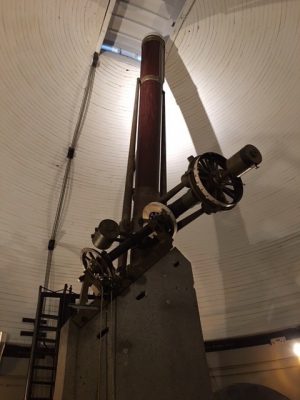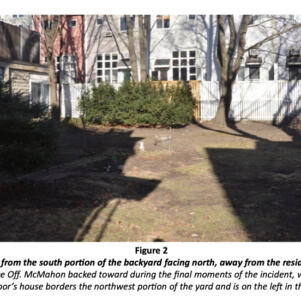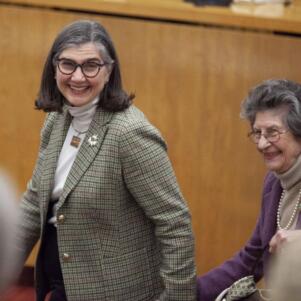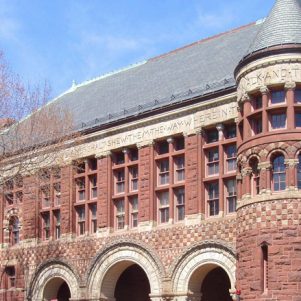The BLOG: Culture
Big Bang Theory
Diane Kilgore | April 12, 2017

Think astrophysics is over your head? Think again!
The Center for Astrophysics (CfA) in Cambridge encourages visitors of all ages to reach for the moon, the stars and furthest margins of our universe’s dusty fingerprint with help from it’s mother-ship at the Harvard-Smithsonian Astrophysical Observatory. Located at 60 Garden Street the nucleus of the Center revolves around a scandal as old as time, American ingenuity and inter-galactic Big Bang theories far more exciting than those from TV shows.
Cozied into a neighborhood, grounded in urban landscapes, is an unassuming brick complex where things are always looking up; way,way up. Two gigantic telescopes are housed in the double-domed office park where 300 scientists and 400 support staffers spend their days thinking in celestial ways. The out-of-this-world research center is also a teaching facility frequently offering free non-technical lectures and observational opportunities to the public.

This collaborative space of interplanetary investigators from Harvard College and the Smithsonian Institute includes scientists from NASA and is one of many projects inspired by an unlikely and stellar bequest of $500,000.00. In 1765, James Smithson was born in secret in Paris as the illegitimate son of a royal widow and a wealthy Englishman. Educated at Oxford University, well-traveled Smithson was considered by classmates to be the best chemist and mineralogists of his time. Applying his limitless curiosities to everything from the magnificent to the mundane Smithson authored twenty-seven scientific papers. Expanding the orbits of research, his studies also included the chemistry of ladies’ tears, how to improve coffee-making and the properties of snake venom.
Smithson died at 64 in Genoa, Italy in 1829. Never having visited the United States only speculation explains why he willed his fortune of more than a half million dollars to establish the Smithsonian Institute in Washington. The life-long bachelor’s gift to be used “for the increase and diffusion of knowledge” lead to controversy and more than a decade of debate over the constitutionality of accepting a national endowment for education. Former President John Quincy Adams and other federalists encouraged legislators to accept the inheritance in 1846 ultimately linking the Institution to our Nation’s identity. With nineteen museums, the National Zoo, and nine research facilities, the Smithsonian is now the world’s largest museum, education and research complex.
Of those research facilities, the Harvard-Smithsonian Center for Astrophysics, located a mile west of Harvard Square, applies the principles of six scientific disciplines to understanding the origin, evolution and fate of the Universe. The Center’s focus explores solar systems and questions what conditions support life. Highlights of twenty-five years of their research include measurement of atmospheric ozone levels, consideration of our Moon being the result of a collision between Earth and another body as well as a mapping of the Southern Hemisphere identifying more than 14,000 galaxies.
Christine Pulliam, Public Affairs Specialist of the Harvard-Smithsonian Center, considers a CfA article published in July of 2013 to be one of her favorites. Written in layman’s terms “Earth’s Gold Came from Colliding Dead Stars” explains the universal source of gold’s glitter to be the flashy result of cataclysmic celestial collisions. The article explains in June of that year, 3.9 billion light-years away from Earth, an extremely energetic burst of gamma-rays lasting less than two-tenths of a second produced an exotic slow-fading light detected by NASA’s Swift satellite.
Researchers at the Astrophysics Center interpreted the infrared pattern of flash as evidence of a collision between two star-cores or neutron stars. They see explosive deaths of massive stars as “momentous events in the cosmos, dispersing into space all of the chemical elements essential for making planets and life.” They calculated “the amount of gold produced and ejected during the merger of those two neutron stars may be as large as 10 moon masses.” As they say at the CfA, “that’s a lotta bling.”
Pulliam says three very exciting “up”-coming events to watch for include the March, 2018 launch of TESS: Transiting Exoplanet Survey Satellite, the first ever space-borne, all-sky surveyor of planets monitoring the brightness of more than 200,000 stars. Getting ready for lift-off between July and August of next year is the Solar Probe Plus, a NASA mission designed to revolutionize our understanding of our sun providing new data on solar activity that helps forecast space-weather and it’s impact on Earth. October of 2018, NASA will launch the James Webb Telescope, the premier observatory for the next decade, allowing astronomers world wide to study the Big Bang’s first light, and the formation of solar systems capable of supporting life on planets like Earth.
Reflecting Smithson’s belief that the pursuit of scientific knowledge is the key to happiness and prosperity the CfA hosts a series of free events open to the public at 60 Garden Street in Cambridge:
Observatory Nights:
Themed, non-technical lectures are offered the third Thursday of each month from the Phillips Auditorium observatory roof (weather permitting, excluding June, July and August)
Star Party Special Events:
April 22~ view Jupiter, double stars, star clusters and more through the telescope
April 23 ~fun for all ages become an astronomer for the day with hands on activities, telescope tours, and “ask the astronomer” booths.
For more information or to sign up for events
call: 617 495 7461 or
email: [email protected].
To follow the progress of NASA launches on Twitter :
@NASA_TESS
@SolarProbePlus
@ NASAWebb
For more even fun and an occasional pun follow:
Astrophysicist Neil deGrasse Tyson @neiltyson






